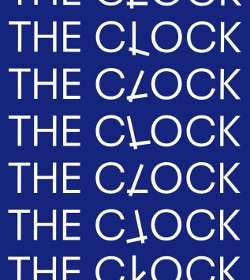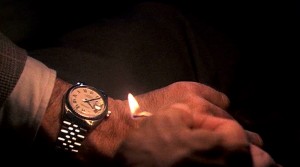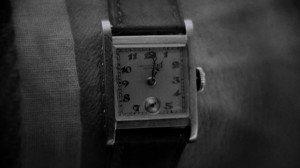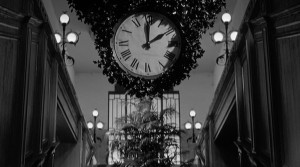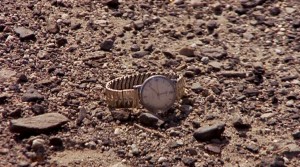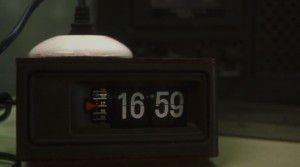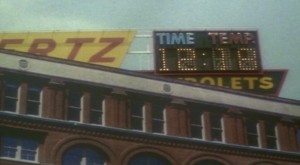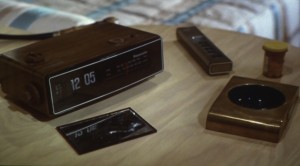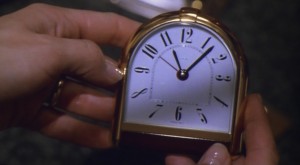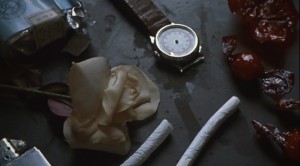TIME, THOU SHALL NOT BOAST
Christian Marclay’s 2010 24-hour found-footage movie The Clock really is a clock: The 12,000-clip montage is only shown synchronized to local time, and through September 7 it’s running as an installation during LACMA hours. You can tell time by it. As a philosophical and spiritual reverie, it also tells time by you. It’s as close as I’ve ever felt to being watched by a movie.
I came in about a quarter to noon, burnt dry from walking a Tar Pit block in August heat and from the weirdness of walking into a movie already underway. But the artist’s exhibit wrapped me in the museum-cool of the movies before a bright, commanding screen, directing focus better than most stadium movie theaters. As I sat, a uniformed Christopher Walken showed me a wristwatch – quarter to twelve – and told me its travels, in Vietnam and toward Los Angeles. Then he handed off the watch from Pulp Fiction to some other picture, and together, 100 years of movie stars and I lived out the minutes before twelve.
Dmitri Tiomkin’s manic High Noon march droveseveral clips in which noon threatened violence: Gary Cooper blinked at his office clock and loaded his revolver. In Run Lola Run, Moritz Bleibtreu checked his watch and pistol outside a bank. But Alain Delon, yachting, and Gregory Peck brooding in a flying jacket, weren’t worried about the time; their movies just happened to be called Purple Noon and 12 O’Clock High. Charlie Chaplin clocked out for lunch in Modern Times. For a pensive John Randolph, seconds ticked by in a movie called Seconds. But after all that, not much gunplay from Christian Marclay; instead high noon popped off with Charles Laughton, cackling and molesting the bells of Notre Dame to show off for Maureen O’Hara in the William Dieterle version of Hunchback. And then Laurence Olivier’s Hamlet decided to remember poor Yorick for a minute, only in the middle of the afternoon instead of the middle of the night.
It might look arch and clever written down, or fussy or precious. In real time, substituting Quasimodo and Esmeralda for Gary Cooper’s revolvers was a magic carpet. Humanist subversions are only a part of this thing. Christian Marclay’s control of tone over an array of appropriated media is sensitive and eager and mature. It is a convincing vision. At its best, assemblage art repurposes other people’s work into clay; Marclay makes of it an empathy delivery system. It’s noon for all of us, but he’s eating, she’s driving, I’m in a theater, they’re digging a grave, awash in the diversity and sameness of our stories.
After noon, The Clock became less urgent, more ruminative. Folks ate a sandwich, had a cigarette. A number chatted about whether it was too early to start drinking. They got on escalators, rose, fell, in English, in French, in Chinese, in Russian. I waited with them for phones to ring, for trains to come, for other people to stop talking. I breathed in communion with a worldwide family.
Collage is a concentrated medium, and can be taxing to consume. Within five minutes of sitting down, I thought I might be watching the best movie I’d ever seen. After 15 minutes, I was sure of it. And at two and a half hours I was done, a little hungry, the exhibit’s IKEA couch a little stiff. I wanted to do some shopping, and the traffic home was going to be miserable if I stayed much longer, so I left with no compunction and I don’t regret it. The movie made me want to spend my time well and so I went and did that.
And I’d have gone back after hours if LACMA would have let me. The Clock would still have been playing: In order for the complex electronic elements to stay in synch with each other and with temporal reality, the movie keeps playing all night long. After the doors close and the docents go home, in the dark of its cryptlike exhibition room, the movie’s still telling its tale to the humming world around.
But unless LACMA decides to run another midnight-to-midnight 24-hour showing as it did in 2011 and earlier this summer, you can only see the parts between 10 a.m. and 8 p.m. (check daily hours). I understand that among much else, I missed late-afternoon commuting sequences, followed by a lot of dinner and dancing, some nighttime chases, some lovemaking, and in the REM-sleep hours, several dream sequences; after dawn characters wake, breakfast, make more love, go to work. Tints of individual narrative run through the hours, setting up expectations and touchstones, relationships. Found-footage montage is an especially rich form in which to create patterns and echoes, to maintain tone poems or to flip them.
Primarily known previously as a composer, Marclay can seem like an accidental purveyor of cinematic invention, but it’s not true. In the 1970s the Swiss-American glued parts of different vinyl records together and investigated sound collage with turntables as a compositional medium. When an artist keeps his sense of humor, it can be hard for professionally ascetic critics to take him seriously. His musicianship has been credited with genius and accused of grandiosity.
While scoring a film, he imagined a real-time montage movie. He persuaded a London gallery to finance the project for a hundred thousand dollars, and he hired a team of footage-finders (he wasn’t really a movie guy) and started editing. Over three years’ work, he fired at least one person who kept suggesting inherently exciting clips – one assistant described Marclay’s aesthetic parameters as “banal but visually interesting.” Eventually he had to hire other geniuses to invent software programs to align, execute and play back The Clock, likely the largest single Final Cut Pro movie file on earth.
The investment paid off: Marclay made six “editions” of the movie and immediately sold five of them to museums for almost half a million dollars each, plus one to a billionaire for an undisclosed sum. The question of copyright – always an issue for commercial artists – doesn’t seem to have troubled him. In what must be one of the most remunerative of all Fair Use claims, he has sought copyright clearance for none of his appropriated footage, and on his sales has paid royalty to nobody. The Clock won the Golden Lion at the Venice Biennale in 2011, and after forty years of pursuing art unmolested by the larger public, Marclay was an international star.
There’s a good reason. Few guns, more bells: He regenerates vivid material, avoids the sensational, pursues a hypnotic repetition. Some of the people around me in the dark were done after a minute or two; some enjoyed whispering the names of the movies they recognized, until that wearied; several of us stayed an hour or more. Either it’ll sieze you within a few minutes, or it won’t; and if it doesn’t, you’ll get to go and have some other moment instead.
________
other pure cinema articles by Jason Rohrer:
Gyorgy Palfi’s Final Cut: Ladies and Gentlemen
Ron Rocheleau’s Concrete T.V.
________
photos by Todd-White Art Photography
poster design by Boris Meister
The Clock
Christian Marclay (United States, b. 1955)
UK | 1440 minutes
Los Angeles County Museum of Art
Art of the Americas Building, 5905 Wilshire Blvd
on view through September 7, 2015 (closed Wednesdays)
for tickets, call 310.247.3049 or visit www.lacma.org
